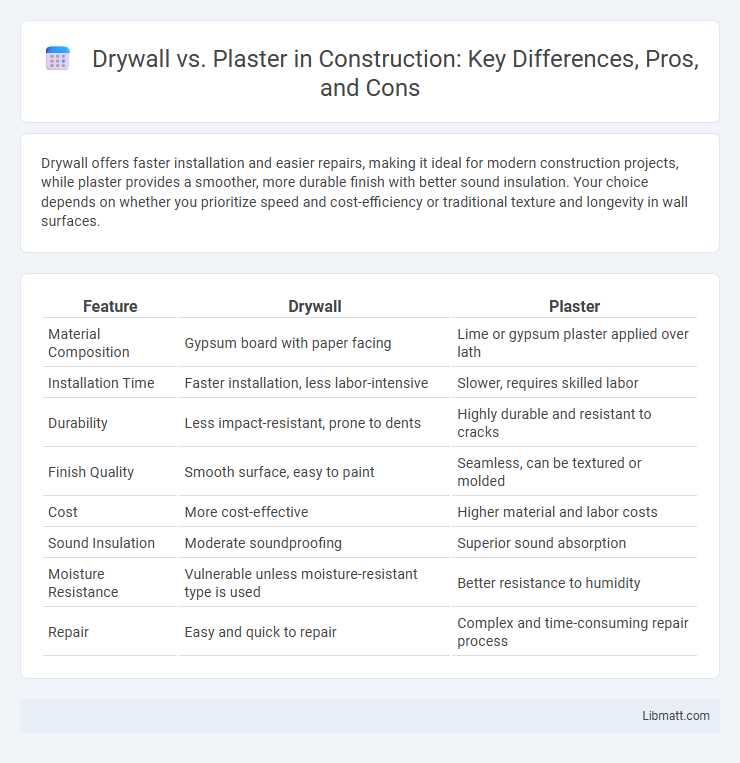Drywall offers faster installation and easier repairs, making it ideal for modern construction projects, while plaster provides a smoother, more durable finish with better sound insulation. Your choice depends on whether you prioritize speed and cost-efficiency or traditional texture and longevity in wall surfaces.
Table of Comparison
| Feature | Drywall | Plaster |
|---|---|---|
| Material Composition | Gypsum board with paper facing | Lime or gypsum plaster applied over lath |
| Installation Time | Faster installation, less labor-intensive | Slower, requires skilled labor |
| Durability | Less impact-resistant, prone to dents | Highly durable and resistant to cracks |
| Finish Quality | Smooth surface, easy to paint | Seamless, can be textured or molded |
| Cost | More cost-effective | Higher material and labor costs |
| Sound Insulation | Moderate soundproofing | Superior sound absorption |
| Moisture Resistance | Vulnerable unless moisture-resistant type is used | Better resistance to humidity |
| Repair | Easy and quick to repair | Complex and time-consuming repair process |
Introduction to Drywall and Plaster
Drywall, also known as gypsum board, consists of gypsum plaster sandwiched between two heavy paper sheets, offering a quick and cost-effective wall finishing option widely used in modern construction. Plaster, a traditional wall coating made from lime, sand, or gypsum, provides a hard, durable surface with excellent soundproofing and fire resistance properties. While drywall installation typically requires less labor and time, plaster offers superior texture customization and long-lasting strength ideal for restoration projects.
Historical Background and Common Uses
Drywall, developed in the early 20th century, revolutionized interior wall construction with its quick installation and cost efficiency, replacing traditional plaster walls used extensively since ancient civilizations. Plaster, made from lime, sand, and water or gypsum, was the primary wall finishing material for centuries, valued for its durability and aesthetic versatility in historic buildings and decorative moldings. Today, drywall is commonly used in modern residential and commercial construction for speed and ease, while plaster remains favored in restoration projects and high-end finishes for its superior soundproofing and smooth texture.
Composition and Material Differences
Drywall consists primarily of gypsum plaster sandwiched between two thick sheets of paper, offering a lightweight and easy-to-install solution for interior walls. Plaster is made from a mixture of lime, sand, and water or gypsum combined with additives, creating a dense, hard surface applied directly onto lath or masonry. The fundamental difference lies in drywall's prefabricated panel form versus plaster's wet application process, impacting durability, texture, and repair methods.
Installation Process Comparison
Drywall installation involves attaching gypsum panels to wall studs using screws or nails, followed by taping and mudding seams to create a smooth surface ready for painting or wallpapering. Plaster installation requires applying multiple layers of wet plaster over a lath framework or existing surfaces, demanding skilled labor for proper curing and finishing. Drywall offers faster installation with less drying time, while plaster provides superior durability and sound insulation but requires a longer, more labor-intensive process.
Cost Analysis: Drywall vs Plaster
Drywall installation typically costs between $1.50 to $3.50 per square foot, making it a more budget-friendly option compared to plaster, which ranges from $6 to $12 per square foot due to labor-intensive application and drying times. Your choice impacts overall renovation expenses, with drywall offering quicker installation and reduced labor costs. For cost-effective home improvement, drywall remains the preferred material for both residential and commercial projects.
Durability and Longevity
Drywall offers moderate durability suitable for most residential interiors but is prone to dents and moisture damage, reducing its longevity in high-impact or damp environments. Plaster walls provide superior hardness and resistance to wear, often lasting over 100 years with proper maintenance due to their dense, cement-like composition. Historic buildings often feature plaster for its unmatched durability, while modern constructions favor drywall for faster installation despite its comparatively shorter lifespan.
Insulation and Soundproofing Capabilities
Drywall offers moderate insulation and soundproofing properties, often enhanced with fiberglass or foam insulation behind the panels for improved thermal and acoustic performance. Plaster provides superior soundproofing due to its density and multi-layer application, effectively reducing noise transmission between rooms. For homes prioritizing energy efficiency and quiet environments, plaster walls deliver more robust insulation and soundproofing benefits than standard drywall installations.
Maintenance and Repair Considerations
Drywall maintenance typically involves simple patching techniques using joint compound and drywall tape, making repairs straightforward and cost-effective compared to plaster. Plaster repairs require skilled labor to match texture and finish, which can be time-consuming and more expensive due to its brittle nature and potential for cracks over time. Understanding these differences helps you choose the most practical option for ongoing upkeep and durability in your home.
Aesthetic and Design Flexibility
Drywall offers a smooth, uniform surface ideal for modern, minimalist designs and can easily be painted or textured to suit various aesthetic preferences. Plaster provides superior sculptural and decorative possibilities, allowing for intricate moldings, curves, and detailed textures that enhance classic or ornate interiors. Designers often choose plaster for its ability to create custom, high-end finishes, while drywall is favored for its versatility and cost-efficiency in contemporary spaces.
Which Should You Choose: Drywall or Plaster?
Drywall offers faster installation and cost-efficiency, making it ideal for most modern renovations and repairs. Plaster provides superior sound insulation and a smooth, durable finish, preferred for historic restorations or high-end projects. Your choice depends on budget, project timeline, and desired aesthetic quality.
Drywall vs plaster Infographic

 libmatt.com
libmatt.com